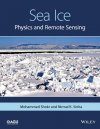![Sea Ice Sea Ice]()
Click to have a closer look
About this book
Contents
Related titles
About this book
An outstanding feature of Sea Ice is the study of sea ice crystalline structure. Ice growth history, as inferred from crystalline structure revealed in ice thin-section photographs will be presented in details. This will explain the influence of weather and oceanic conditions on new ice formation, ice growth, aging and decay processes. In addition, it will describe mechanisms of surface processes in young, first-year and multi-year ice (e.g. brine channel interconnection, surface melt water percolation in multi-year ice, the "survival of the fittest" ice crystal during their growth, etc.). The study will also be supported by high quality photographs of ice thin-sections prepared from cores of different ice types (all obtained by the authors during field experiments in 1980s throughout 1990s using photographic cameras and scanning microscopy). Most of these data have not been published. The photographs are quite revealing of geometrical details of crystalline structure and inclusions in sea ice (liquid brine and air bubbles). Scanning microscopy shows the micro-scale contents of those inclusions (e.g. solid salt within brine pockets).
Another unique feature of Sea Ice will be linking remote sensing (radiometric) observations to the ice physical properties and crystalline structure. For example, why radar backscatter is high in cross polarization (e.g. HV) from surfaces with geometrical shape (e.g. ice ridges), why microwave emission increases when the ice surface or its snow cover become wet, why backscatter continues to decrease during the surface melt season, etc. Those detailed physical descriptions, which are summarized from previous studies and also developed by the authors based on their own observations, will hold educational value and practical use for people who work on ice parameter retrieval from remote sensing (e.g. remote sensing data assimilation into ice-ocean coupled models). Observations and data obtained during the extensive Canadian Arctic exploration programs that started 1998 (NOW'98 and CASES) will constitute the core information for this theme.
The presentation of sea ice parameter retrieval from remote sensing observations will also be unique in two ways. First, it will focus on reviewing recent methods and results (developed in late 1990s and beyond), which have not been covered in previous reviews. The review will be critical in that it will reveal potential and limitations of applications of such methods not only according to authors but also based on experience of other users. Secondly it will also focus on remote sensing data synergism, allows retrieval of parameters that cannot be otherwise retrieved from a single sensor data set.
The educational value of Sea Ice will also be reflected in the presentation style. Each chapter will start with basic principles and continue gradually with more advanced material. The illustrations and high quality photographs will add to the educational value. "Seeing" physical processes that take place during ice formation and growth (e.g. planar or dendritic crystal boundaries in relation to the bulk ice salinity, solid ice within air bubbles in multi-year ice, etc.) will help to develop a permanent impression in the mind of the reader.
Contents
1. Sea ice physical, dielectric and radiometric properties
1.1 Sea ice phase diagram
1.2 Sea ice growth under different oceanographic and atmospheric conditions
1.3 Thickness-based ice types
1.4 Physical properties of sea ice
1.5 Dielectric properties of ice type
1.5.1 Measurements of complex dielectric constant
1.5.2 Modeling complex dielectric constant
1.6 Radiometric properties of ice types
2. Ice Crystalline Structure
2.1 Hexagonal structure and birefringence of ice
2.2 Thin ice section double microtoming technique
2.3 Sea ice fabric diagram
2.4 Categories of ice crystalline structure
2.5 Young and First-Year ice crystalline structure
2.6 Multi-year ice crystalline structure
2.7 Aging processes in sea ice
3. Sea Ice mechanics
3.1 Test techniques for determining mechanical properties of ice
3.2 Elastic properties
3.2.1 Modeling Elasticity of PolycrystallineSea Ice
3.3 Rheology
3.4 Tensile and compressive strength
3.5 Modeling aspects of ice strength
4. Remote Sensing of Sea Ice with Snow Cover
4.1 Electromagnetic wave emission
4.1.1 Optical and infrared emission
4.1.2 Passive microwave emission
4.2 Radar remote sensing
4.2.1 Fundamentals of radar remote sensing
4.2.1.1 Imaging radar sensing
4.2.1.2Profiling radar sensing
4.2.1.3 Radar polarimetry
4.2.2 Radar backscattering from sea ice and snow
4.2.2.1 Backscatter Modeling
4.2.2.2 Backscatter measurements
4.2.2.3 Backscatter database
4.3 Operational analysis of remote sensing data
4.4 Sea ice parameter retrieval from remote sensing observations
4.1 Ice concentration
4.2 Ice types
4.3 Thickness of thin ice type
4.4 Ice surface temperature
4.5 Ice surface roughness
4.6 Snow depth over sea ice
Customer Reviews






































